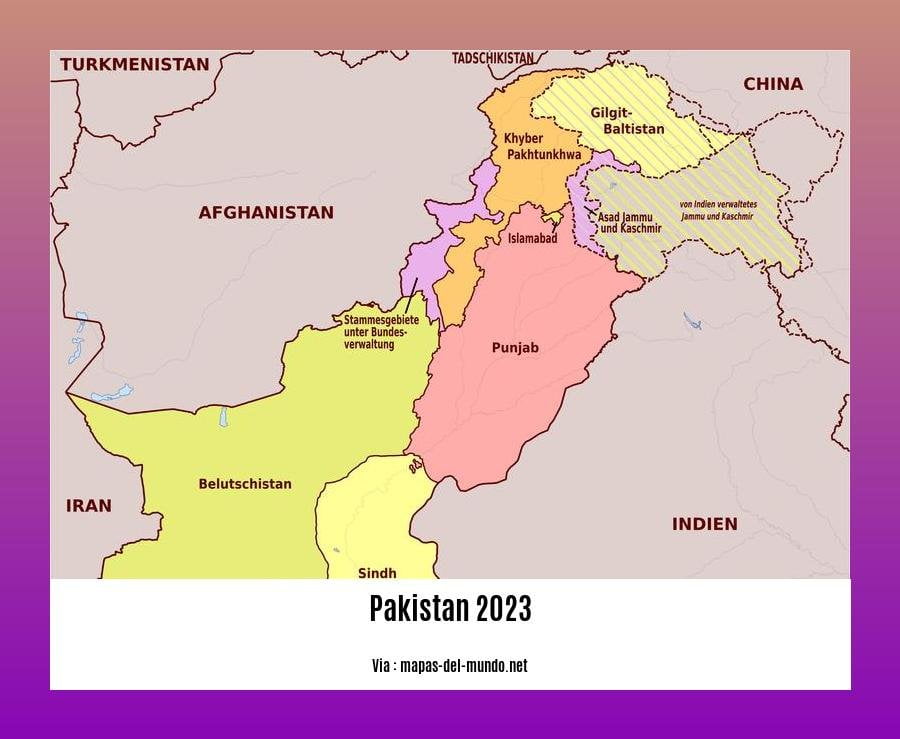Unveiling Pakistan’s Multifaceted Identity: 5 Interesting Facts About Pakistan
Discover the hidden gems and fascinating revelations that await you as we embark on a journey to unveil the multifaceted identity of Pakistan. In this captivating article, we will delve into five intriguing facts about this enchanting nation. From its historical marvels to breathtaking landscapes, unique traditions, and engaging anecdotes, Pakistan’s rich heritage will come to life through meticulously crafted prose. Prepare to be amazed as we navigate through the lesser-known aspects that make Pakistan a truly captivating destination for cultural exploration.
Key Takeaways:
- Pakistan is the 5th most populous country in the world and the second largest Muslim country, with over 220 million people.
- Pakistan is the only Muslim nation with nuclear weapons, making it a significant player in international geopolitics.
- Malala Yousafzai, a Pakistani activist, is the youngest Nobel Prize laureate, advocating for girls’ education.
- The Tarbela Dam in Pakistan is the world’s largest earth-filled dam, providing water and hydroelectric power.
- Pakistan’s strategic location between the Middle East and Asia gives it geopolitical significance, sharing borders with Iran, Afghanistan, China, and India.
- Islamabad is the capital city of Pakistan, with Karachi as the largest city. Urdu and English are the official languages.
- Pakistan’s currency is the Pakistani Rupee (PKR).
- Pakistan is known for its breathtaking mountain scenery, including K2, the world’s second-highest peak.
- Pakistan was the first Muslim-majority country to have a female head of government, Benazir Bhutto.
- Mohenjo Daro, an ancient archaeological site, is a UNESCO World Heritage Site and showcases Pakistan’s rich historical heritage.
5 Interesting Facts About Pakistan

Pakistan, a fascinating nation nestled in South Asia, is a treasure trove of history, culture, and natural beauty. Let’s delve into the multifaceted identity of Pakistan and uncover five intriguing facts that make it a captivating destination.
1. Population and Cultural Diversity
Pakistan is the fifth most populous country in the world, boasting a vibrant population of over 220 million people. What sets Pakistan apart is its incredible cultural diversity, with influences from various ethnicities, languages, and religions. From Punjabis in the east to Sindhis in the south, Balochis in the west, and Pashtuns in the north, Pakistan’s cultural tapestry is a vivid mosaic.
2. Land of Ancient Civilization
Did you know that Pakistan is home to the ancient archaeological site of Mohenjo Daro? This UNESCO World Heritage Site dates back thousands of years and was once part of the flourishing Indus Valley Civilization. Exploring the remnants of this ancient city is like stepping into a time capsule and unraveling the secrets of a bygone era.
3. Rich Cultural Heritage
Pakistan’s cultural heritage is an enchanting blend of traditions, arts, and crafts. From the intricate handiwork of artisans in Multan’s blue pottery to the vibrant hues of Phulkari embroidery in Punjab and the mesmerizing dances and music of Sindh, each region boasts its unique cultural expressions. Immerse yourself in Pakistan’s rich heritage and unlock the stories passed down through generations.
4. Stunning Landscapes and Natural Wonders
Prepare to be awe-inspired by Pakistan’s breathtaking landscapes. The country is home to K2, the world’s second-highest peak, and a paradise for trekking enthusiasts. With over 108 peaks standing tall at 7,000 meters or higher, the Karakoram and Himalayan ranges offer a spellbinding playground for adventure seekers. From lush green valleys and roaring rivers to serene lakes and expansive deserts, Pakistan’s natural wonders captivate and enthrall.
5. Crossroads of History and Geopolitics
Strategically located, Pakistan serves as a bridge between the Middle East and Asia. Its borders with Iran, Afghanistan, China, and India have shaped its history and given it a unique geopolitical significance. Pakistan’s role in regional stability and its influence in international affairs make it an essential player on the world stage.
In conclusion, Pakistan’s multifaceted identity is a tapestry interwoven with fascinating facts and rich history. Its diverse population, ancient civilizations, rich cultural heritage, stunning landscapes, and geopolitical importance make it a destination that promises to leave a lasting impression. Embark on a journey to Pakistan and discover the depths of its captivating character.
Did you know that Pakistan has 5 amazing facts waiting to be discovered? From stunning landscapes to rich cultural heritage, you won’t want to miss out. Come and explore these wonders at 5 amazing facts about Pakistan.
Want to learn more about Pakistan? Check out these intriguing 5 facts about Pakistan that will leave you amazed. Find out all the fascinating details at 5 facts about Pakistan.
Pakistan’s Rich Cultural Heritage: A Journey Through Time
Pakistan, a land blessed with a storied past and diverse cultural heritage, holds a treasure trove of history and traditions. From the ancient civilizations of the Indus Valley to the influences of Persian, Indian, and Central Asian cultures, Pakistan has a rich cultural heritage with influences from various civilizations and conquerors. Let’s explore five intriguing facts that unveil the lesser-known aspects of Pakistan’s multifaceted identity.
Fact 1: Gilgit-Baltistan – A Natural Wonderland with Unique Traditions
One of the regions in Pakistan that boasts awe-inspiring natural landscapes is Gilgit-Baltistan (GB). Situated in the Karakoram range, GB is home to some of the highest peaks in the world and is known for its picturesque scenery and distinctive cultural heritage. Imagine standing at the foot of towering mountains, admiring their majestic beauty while being immersed in the rich traditions of the local communities. It’s a unique experience that can only be found in Pakistan.
Fact 2: A Melodic Tapestry of Music, Dance, and Literature
The cultural heritage of Pakistan encompasses various elements such as music, dance, literature, and cuisine. Pakistani music, with its rich history spanning centuries, showcases diverse styles including classical, folk, and Sufi. It is a harmonious blend of influences from Persian, Indian, and Central Asian cultures, contributing significantly to Pakistan’s cultural identity. Feel the rhythms of traditional musical instruments and witness the graceful movements of dancers, as they tell stories that have been passed down through generations.
Fact 3: Islam’s Profound Influence on Culture and Everyday Life
Pakistan’s status as an Islamic state since 1956 has had a profound impact on its cultural heritage. Islam has become deeply intertwined with various aspects of Pakistani culture and everyday life. This injection of Islamic values and traditions has shaped the historical values of the Muslim-majority population. Step into Pakistan’s vibrant streets and witness the manifestation of Islamic traditions in the architecture, clothing, and the warmth of its people.
Fact 4: Preserving Ancient Heritage Sites and Traditions
Pakistan is also home to numerous heritage sites that have been recognized and preserved by organizations such as UNESCO. These sites offer a glimpse into the country’s ancient civilizations and diverse cultural traditions. Walk in the footsteps of history as you explore archaeological wonders like Mohenjo Daro and Taxila, and witness the deep-rooted traditions that have survived the test of time.
Fact 5: A Fusion of Traditional and Contemporary Expressions
In the modern era, Pakistani art, music, and cinema have embraced a fusion of traditional and contemporary elements. This fusion creates unique and dynamic expressions of culture that reflect the vibrant diversity of Pakistan’s society. Immerse yourself in the kaleidoscope of colors, sounds, and stories depicted in Pakistani art and cinema, and witness the blending of past and present in a harmonious symphony.
Key Takeaways:
– Pakistan’s cultural heritage is a testament to its rich history and the contributions of various civilizations and influences.
– Gilgit-Baltistan offers breathtaking landscapes and unique traditions that make it a must-visit region in Pakistan.
– Pakistani music, dance, and literature showcase a diverse cultural tapestry influenced by Persian, Indian, and Central Asian cultures.
– Islam has profoundly shaped Pakistani culture and everyday life since the country’s establishment.
– Pakistan’s heritage sites and preserved traditions provide a window into its ancient civilizations and cultural history.
– Contemporary Pakistani art, music, and cinema combine traditional and modern elements, reflecting the country’s vibrant diversity.
Sources:
– Hilal Publications
– Medium
Pakistan’s Rich and Diverse Cuisine: A World of Flavors

Key Takeaways:
– Pakistani cuisine is known for its delicious and diverse flavors influenced by regional and historical factors.
– The geographical location and cultural influences have shaped the variety of flavors and ingredients found in Pakistani cuisine.
– Traditional dishes like spicy curries, kebabs, and sweet desserts are staples in Pakistani households.
– Colonialism has also had a significant impact on Pakistani cuisine, with some dishes being adapted to suit the tastes of colonial occupiers.
– Pakistani cuisine has gained popularity worldwide and is now being creatively adapted by chefs using new techniques and ingredients.
Pakistan is a land that tantalizes taste buds with its rich and diverse cuisine, influenced by centuries of history and regional flavors. From the spices of the subcontinent to the culinary traditions of Persia and Central Asia, Pakistani cuisine is a delightful blend of tastes and aromas that satisfy even the most discerning palates.
Geographical Influences on Pakistani Cuisine
Source: Awesome Cuisine
One cannot talk about Pakistani cuisine without acknowledging the role of geography. Pakistan’s unique geographical location, bordered by Iran, Afghanistan, China, and India, has shaped its cuisine and contributed to its diverse array of flavors. The merging of different cultures and traditions in these neighboring countries has influenced Pakistani cuisine, resulting in a fusion of spices, techniques, and ingredients.
Traditional Delights that Define Pakistani Cuisine
Source: Awesome Cuisine
When it comes to traditional dishes, Pakistani cuisine offers a tantalizing array that is sure to entice any food lover. Spicy curries bursting with flavor, succulent kebabs grilled to perfection, and sweet desserts like gulab jamun that melt in your mouth are just a few examples of the culinary treasures found in Pakistani households. These dishes reflect the rich heritage and diverse culinary traditions of the different regions within Pakistan.
Colonial Influences on Pakistani Cuisine
Source: Awesome Cuisine
The history of Pakistan’s cuisine is not complete without acknowledging the influence of colonialism. The British, in particular, left an indelible mark on Pakistani culinary traditions. Many dishes were adapted to suit the tastes and preferences of the colonial occupiers, leading to the incorporation of new ingredients and cooking techniques. This fusion resulted in dishes that are now considered quintessentially Pakistani, such as biryani and breaded cutlets.
From Exotic to Beloved: The Popularization of Pakistani Cuisine
Source: Awesome Cuisine
What was once considered “exotic” or “ethnic” food has now become one of the world’s most beloved cuisines. Pakistani cuisine has gained popularity globally, with its flavors and aromas captivating food enthusiasts from all walks of life. The unique blend of spices, slow cooking methods, and the skillful use of herbs make Pakistani cuisine a truly memorable culinary experience.
Contemporary Adaptations: A Modern Twist on Traditional Flavors
Source: Awesome Cuisine
Pakistani cuisine is not stagnant but continuously evolving. In recent years, there has been a surge of creativity among chefs who are embracing their culinary heritage while adding innovative twists to traditional dishes. These modern adaptations use new techniques and ingredients to elevate regional flavors and create a fusion that appeals to a modern audience. From reinvented street food to upscale fine dining, Pakistani cuisine is experiencing a renaissance that showcases its versatility and creativity.
Pakistan’s cuisine is a true reflection of its multifaceted identity. Influenced by regional diversity, cultural exchanges, and historical factors, Pakistani dishes bring together a tapestry of flavors that have delighted generations. Whether you’re savoring traditional dishes or exploring contemporary adaptations, Pakistani cuisine offers an unforgettable journey for your taste buds.
Sources:
– Awesome Cuisine: Provides insights into Pakistan’s diverse cuisine, including the impact of geography, traditional dishes, colonial influences, and contemporary adaptations.
– Chef Reader: Offers information on the unique features of Pakistani cuisine, including the emphasis on spices, slow cooking, and the main components of a meal.
Pakistan’s Majestic Peaks: Unveiling a Natural Wonder
Pakistan is known for its breathtaking landscapes and stunning natural beauty. One of the most remarkable features of this vibrant nation is its majestic mountains. Pakistan is home to some of the highest peaks in the world, including K2, the second-highest mountain on Earth. Let’s dive into the fascinating realm of Pakistan’s rich heritage and explore five interesting facts about its awe-inspiring peaks.
1. The Karakoram Range: A Mountain Lover’s Paradise
Nestled in the heart of Pakistan, the Karakoram range stands tall as a veritable paradise for mountain enthusiasts. This majestic range is home to most of the highest mountains in Pakistan, including K2, which boasts a staggering height of 8,611 meters and ranks as the second-highest peak globally. The Karakoram range embraces adventurers with its awe-inspiring beauty and offers a thrilling playground for mountaineers seeking the ultimate challenge.
2. The Eight-Thousanders: A Feast for the Adventurous Soul
Pakistan is a proud host to some of the world’s most coveted peaks known as the eight-thousanders. These independent mountains, soaring beyond 8,000 meters, capture the imagination of mountaineers worldwide. Situated near Concordia, the confluence of the Baltoro Glacier and other glaciers, these eight-thousanders create a breathtaking panorama that leaves visitors in awe of nature’s grandeur.
3. Countless Peaks and Uncharted Wonders
With an astounding total of 108 peaks exceeding 7,000 meters and a staggering 4,555 peaks surpassing 6,000 meters, Pakistan boasts an impressive collection of towering summits. However, it’s essential to note that the list of mountains in Pakistan is incomplete, with numerous named and unnamed peaks yet to be explored and discovered. The allure of uncharted wonders beckons adventurous souls to set foot on these awe-inspiring peaks and become part of their extraordinary history.
4. Exploring Beyond the Karakoram Range
While the Karakoram range takes center stage in Pakistan’s mountainous landscape, other high mountain ranges dot the country. These lesser-known ranges offer their own unique beauty and charm to intrepid explorers. From the breathtaking beauty of the Himalayas in the north to the rugged Sulaiman and Hindu Kush ranges in the west, Pakistan’s diverse geography provides a rich tapestry of mountainous wonders waiting to be explored.
5. Cautions and Incomplete Surveys: Finding the Summit’s Truth
As aspiring adventurers embark on their quest to conquer Pakistan’s highest peaks, it is crucial to exercise caution and be aware of incomplete surveys and imprecise elevation data. Determining whether a mountain is a single summit or multiple peaks can be ambiguous, adding an extra layer of mystery to these majestic summits. Only through precise and consistent surveys can we uncover the true nature of these towering peaks and their place in the annals of mountaineering history.
Key Takeaways:
- Pakistan is home to some of the highest peaks in the world, including the renowned K2, the second-highest mountain on Earth.
- The Karakoram range houses most of Pakistan’s highest mountains, offering a paradise for mountain lovers.
- The country embraces the awe-inspiring eight-thousanders, independent mountains exceeding 8,000 meters, captivating adventurers with their grandeur.
- Pakistan’s mountains extend far beyond the Karakoram range, with hidden wonders in the Himalayas, Sulaiman, and Hindu Kush ranges.
- Caution is advised when considering elevation data, as incomplete surveys and ambiguous summit classifications exist.
For further reading and exploration on the mountains of Pakistan, consider referring to the following sources:
- List of mountains in Pakistan – Wikipedia
- High Asia: An Illustrated History of the 7,000 Metre Peaks, by Jill Neate (Mountaineers Books 1990)
Embark on an unforgettable journey to Pakistan’s majestic peaks, where nature’s grandeur and the thrill of adventure converge. Brace yourself for a magnificent experience as you explore these towering giants that make Pakistan such a captivating destination.
FAQ
Q1: What is the population of Pakistan and its religious majority?
A1: Pakistan has a population of over 220 million and is the second largest Muslim country in the world, with a Muslim population of more than 220 million.
Q2: What is the significance of Pakistan’s nuclear weapons?
A2: Pakistan is the only nation in the Muslim world that possesses nuclear weapons, making it a significant player in international geopolitics.
Q3: Who is the youngest Nobel Prize laureate from Pakistan?
A3: Malala Yousafzai, the world’s youngest Nobel Prize laureate, hails from Pakistan. She fought for girls’ education and has become a symbol of empowerment globally.
Q4: What is the significance of the Tarbela Dam in Pakistan?
A4: Pakistan is home to the world’s largest earth-filled dam, the Tarbela Dam. It plays a crucial role in providing water and generating hydroelectric power for the country.
Q5: What are some unique geographical features of Pakistan?
A5: Pakistan serves as a bridge between the Middle East and Asia and shares borders with Iran, Afghanistan, China, and India. Its strategic location makes it a significant geopolitical player in the region.















